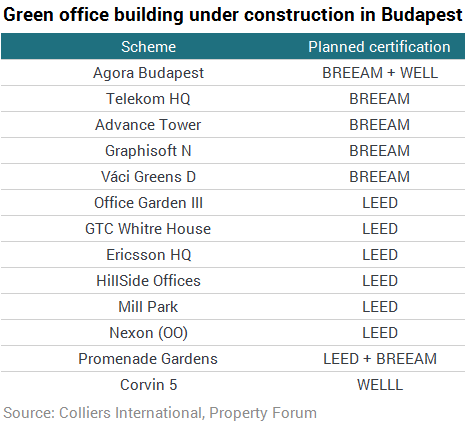
Obtaining a green certificate for modern office buildings has become a must in recent years. Still, developers, operators and tenants don’t fully realise what does a certification actually stand for and what kind of effect green solutions actually have on operating costs and productivity. The latest Green Talk, co-organised by RICS and HuGBC, focused on green buildings in Hungary.
Currently slightly more than one third (34% or 1.14 million sqm) of Budapest’s modern office stock is certified which means that there are 60 green office buildings in the capital. Combined with 2 more office buildings in Debrecen, 8 logistics centres and factories, 5 shopping malls, 2 stadiums, 1 hotel, 1 university and 1 embassy building, 80 properties have been certified in Hungary altogether. The number of certified buildings and area tripled in the last 3 years and we can say that having a building certified is not an advantage anymore, it`s a criteria, Norbert Szircsák LEED AP ID+C, Senior Associate at Colliers International explained in his presentation. Still, even though there are companies that are required on a corporate level to move into green buildings, most tenants still don’t care about certifications.

According to the experts present at the discussion, deciding which certification system to go with mostly comes down to the cost of the certification process. Some developers also consider which system their future buyers prefer and many take into consideration the fact that getting a BREEAM certificate is easier and more achievable than a LEED one. This is not only true for new buildings but for existing ones as well: a BREEAM In-Use certificate can be obtained within a few months, whereas a LEED certification process takes a year to get through. An advantage of LEED is that it has more requirements, which means more numbers for the developer to show to potential tenants and investors.

It was also discussed at the latest Green Talk that, from an architectural point of view, it is difficult to develop green buildings. Unfortunately, most developers are not willing to invest in top quality solutions and materials that would ensure problem-free and low-cost operation in the longer run, something that investors and operators should care more about. It is still usually rather difficult to prove to tenants how a good building will increase efficiency in the workplace, the professionals concluded.



